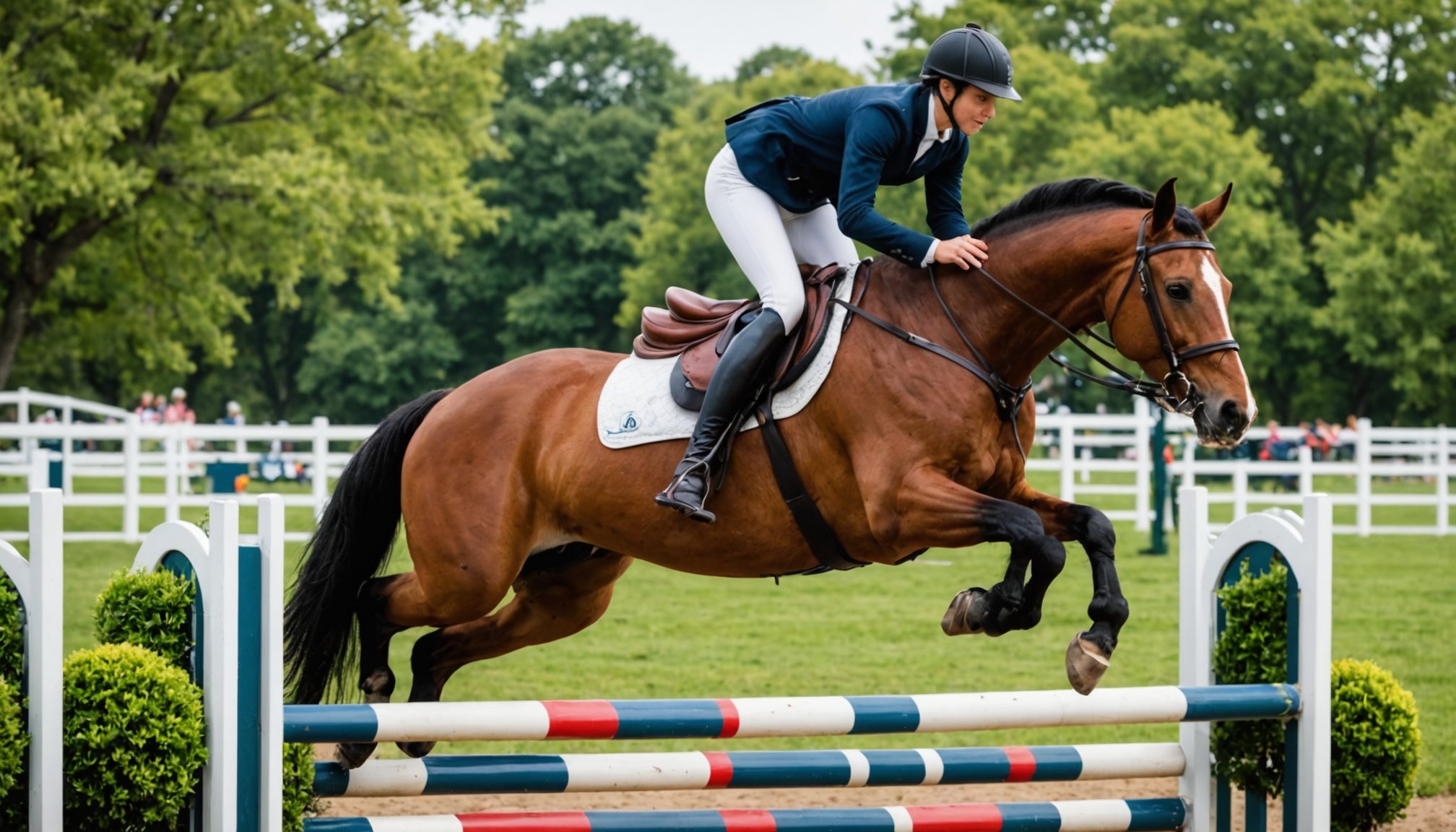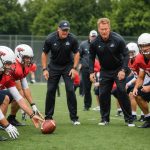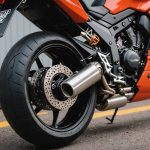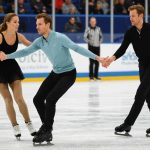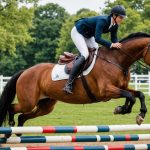Understanding Jumping Techniques
In equestrian sports, mastering fundamental jumping skills is crucial for both rider and horse. These skills form the backbone of more advanced, specialised equestrian techniques that can enhance overall performance.
A key technique involves understanding different types of jumps. Each jump demands a distinct approach and adjustment in performance enhancement. For instance, the ascending oxer requires a longer, more forward stride, while a vertical jump focuses on height over distance.
Additional reading : Achieving tranquility before the glide: key techniques for ice skaters to manage nerves and enhance performance
Additionally, recognising and correcting common physical form mistakes is essential. A prevalent issue with jumping is the rider’s tendency to lean too far forward. This can destabilise the horse’s balance. To rectify this, riders should prioritise maintaining a centred, flexible seat, allowing for optimal horse movement. Similarly, uneven weight distribution in the stirrups can affect control and safety during jumps. A solution is ensuring equal pressure on both stirrups, contributing to a steadier ride.
By refining these jumping skills, riders can significantly influence their success in competitions and training, demonstrating the indispensable link between foundational techniques and advanced equestrian performance.
Have you seen this : Enhancing endurance: proven training techniques for cyclists tackling multi-stage competitions
Physical Preparation for Jumping
Achieving optimal performance in equestrian jumping requires a strong focus on fitness training. Riders benefit greatly from a tailored approach that enhances both strength and flexibility for jumping.
Rider strength is crucial given the physical demands of horseback jumping. Targeted exercises that build core stability and leg power help maintain precision and control during jumps. Squats and lunges are particularly effective, reinforcing muscles used while riding. Additionally, incorporating activities like pilates or yoga can bolster overall body awareness and support strength development.
Flexibility for jumping enhances a rider’s ability to adapt quickly while maintaining the proper form. Stretches targeting the hip flexors, hamstrings, and lower back can increase flexibility, ensuring smoother transitions and reducing injury risks. Regular practice of these exercises creates a balance between muscular endurance and flexibility.
Before each jumping session, a comprehensive warm-up is recommended. This should include dynamic stretching to appropriately prepare muscles and joints. Warming up not only primes muscle groups but also aids in mental focus, enhancing the rider’s performance. A routine combining light jogging and bodyweight exercises can effectively activate the body’s systems for more effective jumping.
Mental Preparation and Focus
Approaching jumping can be daunting, with mental barriers often proving the most significant challenge for riders. Developing effective mental strategies is crucial. Riders may experience fear of failure, anxiety, or lack of confidence. Addressing these concerns begins with confidence building. Start small, acknowledging achievements, and gradually tackling more challenging jumps to bolster self-assurance.
Focus techniques are instrumental in managing distractions. Techniques such as deep breathing and mindfulness help maintain composure. Concentrate on the present moment to clear the mind of noise and enhance focus during practice and competition.
A powerful tool in mastering jumping is visualization. Visualizing success strengthens neural pathways, preparing the mind for real-life execution. Envision the perfect jump, from the approach to the landing. This primes the mind and builds a mental library of successful jumps.
Beyond visualizing success, prepare for potential setbacks. Anticipate obstacles and mentally rehearse solutions, instilling greater adaptability and confidence in actual scenarios. Embracing these strategies can eliminate or reduce elements of unpredictability riders face, fostering a resilient and focussed mindset for improved performance.
Effective Horse Communication
Achieving exceptional horse-rider communication requires a foundation of trust and understanding. To enhance this bond, adopting specific training strategies is beneficial. Start with groundwork exercises, which lay the basis for effective communication. These include leading, stopping, and responding to voice commands. Such activities acclimate horses to human interaction and establish leadership.
To further strengthen the bond, incorporate exercises like grooming and mindful riding. Grooming allows for mutual comfort and relaxation, while mindful riding helps riders stay in tune with the horse’s movements and emotions. Developing a shared rhythm during riding strengthens trust.
Monitoring your horse is crucial. Pay attention to signs like relaxed ears, smooth gait, and willingness to follow cues unhesitatingly. These indicators suggest your horse is comfortable and confident. Similarly, noticing tension in the body or ears pinned back can signal discomfort.
Building trust through consistency and patience is vital. Regular, positive interactions improve communication over time, making the partnership more rewarding for both horse and rider. By applying these strategies, you lay a strong foundation for a responsive and trusting relationship, paving the way for effective horse-rider communication.
Training Exercises for Skill Development
To enhance your jumping ability, training drills are invaluable. Focus on exercises like box jumps and plyometric leaps, which are particularly effective. Incorporating these into your practice routines helps improve power and technique swiftly.
Creating effective practice routines is crucial. Start with exercises of moderate difficulty, gradually increasing the complexity as you develop. This progressive difficulty ensures your skills continually advance, reducing the risk of plateaus.
Skill improvement also benefits from variety. Mixing isometric holds with dynamic movements can reinforce muscle stability and power. Consistency is key, but so is diversity within your training sessions to keep your body adapting.
Incorporating training drills that stress different aspects of jumping—such as height, distance, and control—will provide a well-rounded improvement in your ability. Do not overlook rest; it is essential for recovery and prevents overtraining, allowing for optimal skill improvement. Remember, structured practice routines are the foundation of effective training, guiding you to your goals.
Implement these methodologies, and your jumping prowess will surely rise as you hone your technique consistently through targeted training drills.
Analyzing Scoring Criteria
Understanding the equestrian scoring system is crucial for riders aiming for success in jumping competitions. Competition insights reveal that scoring is primarily based on the ability to clear obstacles efficiently while demonstrating grace and control. Judges evaluate each rider on attributes such as speed, precision, and technique.
One of the common pitfalls negatively affecting scores is failing to maintain a seamless rhythm throughout the course. Riders often lose points due to inconsistent speed or knocking down obstacles. To avoid such mistakes, it’s essential to practice maintaining a steady pace and enhancing coordination with the horse.
Innovations in scoring systems are also transforming how judges’ criteria are applied. Advances in technology allow for more precise evaluation of movements and timings, which can provide more accurate feedback for riders. These changes enhance the fairness of competitions and assist participants in identifying areas for improvement.
By understanding the judges’ criteria, riders can refine their skills and strategies, thereby increasing their chances of scoring higher. Adapting to new methodologies not only aids in achieving better performance but also contributes to a more enriching competitive experience.
Common Mistakes to Avoid
In the realm of equestrian sports, jumping mistakes often stem from a lack of preparation or understanding of the basics. Riders frequently misjudge the horse’s stride, leading to incorrect take-off distances. This can result in penalties and negatively impact competitive performance. To enhance success, it is crucial to focus on addressing these errors during practice sessions.
Risk management is another key component often overlooked. Riders should develop a strategic approach by assessing both the horse and the course before competition. Properly planning each jump and anticipating potential setbacks is essential for safety and performance.
Techniques such as video analysis can be employed to assist in identifying the specific mistakes riders make during their jump sequences. By meticulously reviewing footage, riders can pinpoint errors and develop strategies to overcome them. Additionally, consistent feedback from coaches aids in honing the rider’s skills.
Ultimately, understanding and correcting these common mistakes can significantly improve a rider’s competitive performance. The focus should always be on a comprehensive approach, integrating skill development with effective risk management techniques.
Expert Insights and Advice
The world of equestrian sports is vast and increasingly dynamic. Equestrian experts offer invaluable advice on navigating this evolving landscape. Professional interviews with seasoned riders reveal that adapting to current trends is essential. These riders emphasize the importance of continuously updating one’s training regimen to incorporate new techniques.
In an effort to provide practical advice, experts suggest focusing on core stability and rider fitness. This is crucial for improving overall performance and ensuring both horse and rider maintain a harmonious connection. Additionally, groundwork, often underestimated, is highlighted as foundational for refining communication.
To further delve into the intricacies of the sport, some experts recommend engaging with professional training clinics. These clinics provide an opportunity for riders to observe and learn from top-tier instructors. They not only offer a chance to polish riding skills but also grant insights into better managing obstacles and optimizing performance.
For individuals committed to excelling, insider tips from professionals encourage riders to embrace continuous learning. Expanding one’s knowledge through books, documentaries, or seminars can unveil new perspectives and enhance existing techniques. The journey of mastering equestrian sports is both personal and professional, requiring persistence and dedication.

